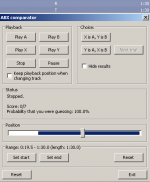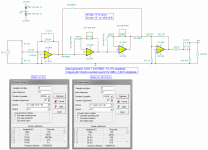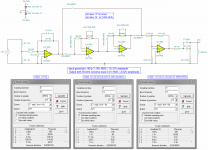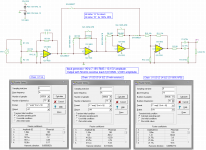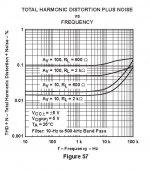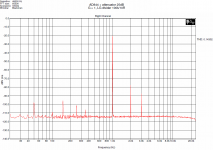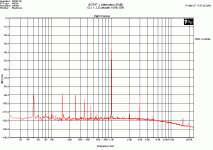Will put up statistically valid results later.
Wow, 0/7 is said to be 100% probability of guessing. How about 0/100? 😛
If interest here is distortion simulation for circuit chains with LM4562.
I'm sick today so I will do the ABX tomorrow.
But wow!! Can you show the distortions with previous opamp (to compare with)??
From quick listening of the three files I got a feeling that I will not prefer direct this time! And LM4562 was the pomegranate!! What's wrong with this opamp!??
crisis here, those AAA,BBB were hard, these R,S,T/L,M,N even harder. See again tomorrow

Fantastic... this is what I was hoping... and you are not alone 🙂
I'm sick today so I will do the ABX tomorrow.
But wow!! Can you show the distortions with previous opamp (to compare with)??
From quick listening of the three files I got a feeling that I will not prefer direct this time! And LM4562 was the pomegranate!! What's wrong with this opamp!??
Hope you are feeling better... we need your input 🙂 Only joking, get well soon 😀
Maybe what is wrong with a lot of these opamps is that we are not using them in optimum configurations. I certainly haven't got all the answers but a bit of practical experimentation seemed a good way to try and see. Depending on how final results and impressions go it might be worth a thread of its own on this.
Misted the first one so went for low score:
View attachment 387106
Will put up statistically valid results later.
But out of gate, these sound significantly different, that I would have definite preference; more on this later too, see if I change my mind after gaining statistical significance.
Hmm, that result is like mine after breakfast the other day.
These are proving tougher up to now though.
Here is simulation:..........But wow!! Can you show the distortions with previous opamp (to compare with)??
From quick listening of the three files I got a feeling that I will not prefer direct this time! And LM4562 was the pomegranate!! What's wrong with this opamp!??
First picture was files AAA/BBB with TLE2071.
Second picture is files R,S,T/L,M,N with LM4562.
Because they don't sit in same config (resistors changed), i put third picture, same as picture 2 but with TLE2071, a setup we not have files for...........Maybe what is wrong with a lot of these opamps is that we are not using them in optimum configurations. I certainly haven't got all the answers but a bit of practical experimentation seemed a good way to try and see. Depending on how final results and impressions go it might be worth a thread of its own on this.
I don't have data for Mooly's setup about source and load but all three threated equal with perfect source Z out 0R, and load is resistor 5Kohm.
Be aware i could have done schematic/config errors/misunderstanding even i tried not to, this can be corrected if Mooly check the schematics.
Attachments
Thanks BYRTT, the circuits look fine. The output impedance of the Marantz is going to be low, it uses their discrete HDAM (or some variety of) buffer stages. Input impedance of the sound card is an unknown but probably nothing drastic drive wise.
I really doubt LTspice with distortion measurements on opamps, although it may well show trends. One area of immediate doubt is the data sheet for the TLE2072 which I assume is correct and that shows the distortion (for a gain of 10) as 0.02% best case. Order of magnitude higher than the sims.
I really doubt LTspice with distortion measurements on opamps, although it may well show trends. One area of immediate doubt is the data sheet for the TLE2072 which I assume is correct and that shows the distortion (for a gain of 10) as 0.02% best case. Order of magnitude higher than the sims.
Attachments
I have my own tests for opamps. Please compare sensitivity of AD844 vs. LME47910 to EMI. One may also see higher noise of the 47910. JFET input opamps are very good in this. Only AD844 and AD797 behave well speaking about BJT input opamps (from those that I have measured).
Attachments
Thanks Pavel. The LM49710 looks very "messy" compared to the AD844 and its well controlled spread of harmonics. Nothing above the 2nd and 3rd. The raw numbers (thd 0.025%) are in favour of the LME though. The influence of rf/hf hash is something I have read about before, a criticism made of the NE5532.
The LM4970 plot looks like it is redistributing noise, and power supply signals into IMD components.
Thanks PMA. For me it looks like every OPamp needs a pro technician to take care of the config and layout the OPamp sits in. And in this manner the different models can all give very good result if taken care off by a pro.
Example i am only hobbyist and have Behringer DEQ2496 where DAC is AKM4393 to NJM4580 and sounds pretty good for me, if i exchange to LME49710 it gets lifeless/clinic, but in other configs the LME can sound exelence. Is there something about this that the config and layout matters and need to relect to used OPamp, and therefor if exchange is done it takes more to be done ?
Example i am only hobbyist and have Behringer DEQ2496 where DAC is AKM4393 to NJM4580 and sounds pretty good for me, if i exchange to LME49710 it gets lifeless/clinic, but in other configs the LME can sound exelence. Is there something about this that the config and layout matters and need to relect to used OPamp, and therefor if exchange is done it takes more to be done ?
The LM4970 plot looks like it is redistributing noise, and power supply signals into IMD components.
Looks like, and it has something in common with input stage.
Thanks PMA. For me it looks like every OPamp needs a pro technician to take care of the config and layout the OPamp sits in.
I agree. But one has much less work to make them behave with JFET opamps. My favorite chips are OPA627, OPA637 (gain >5) and OPA827.
Thanks Pavel. The LM49710 looks very "messy" compared to the AD844 and its well controlled spread of harmonics. Nothing above the 2nd and 3rd. The raw numbers (thd 0.025%) are in favour of the LME though. The influence of rf/hf hash is something I have read about before, a criticism made of the NE5532.
So have a brief look at AD797 under same conditions.
Attachments
Here is simulation:
First picture was files AAA/BBB with TLE2071.
Second picture is files R,S,T/L,M,N with LM4562.
Thanks. But why I see LME49710, not LM4562???
I was expecting this kind of data when I asked for the distortions data after saying that I got a feeling that I will not prefer direct this time.
As you can see, with TLE, the resistor circuit and the 100%FB increase the THD.
With LME, the resistor circuit and the 100%FB REDUCE the THD!! I'm confused.
Last edited:
So have a brief look at AD797 under same conditions.
That is clean although shift to 3rd harmonic dominance. Very low absolute levels and very low thd figure.
Maybe using a mix of different devices would be worhwhile in some opamp intensive applications.
Thanks. But why I see LME49710, not LM4562???
I was expecting this kind of data when I asked for the distortions data after saying that I got a feeling that I will not prefer direct this time.
As you can see, with TLE, the resistor circuit and the 100%FB increase the THD.
With LME, the resistor circuit and the 100%FB REDUCE the THD!! I'm confused.
I think the LME49710 is like a single version of the LM4562 dual. The TLE is not offered as a super low distortion device, the data sheet shows it to be quite modest compared to the the others.
Thanks. But why I see LME49710, not LM4562???
I was expecting this kind of data when I asked for the distortions data after saying that I got a feeling that I will not prefer direct this time.
As you can see, with TLE, the resistor circuit and the 100%FB increase the THD.
With LME, the resistor circuit and the 100%FB REDUCE the THD!! I'm confused.
LM series branding is time consuming, a study for it self. Below is all same except some tested for higher voltage:I think the LME49710 is like a single version of the LM4562 dual. The TLE is not offered as a super low distortion device, the data sheet shows it to be quite modest compared to the the others.
2,5-17V = LM4562(Dual), LME49710(Single), LME49720(Dual), LME49740(Quad)
2,5-22V = LME49860(Dual), LME49870(Single)
Is RST = LMN?
Is R=L, S=M, T=N?
I think I can still differentiate RST tho in ABX thru headphone might not be better than 7/7. But the problem is, no file is good enough. I can't enjoy any of them thru my speakers! They have no soul 🙂 so I'm thinking downloading LMN in case the song or music is "better".
Is R=L, S=M, T=N?
I think I can still differentiate RST tho in ABX thru headphone might not be better than 7/7. But the problem is, no file is good enough. I can't enjoy any of them thru my speakers! They have no soul 🙂 so I'm thinking downloading LMN in case the song or music is "better".
- Status
- Not open for further replies.
- Home
- General Interest
- Everything Else
- Small Signal Listening Comparison Test
